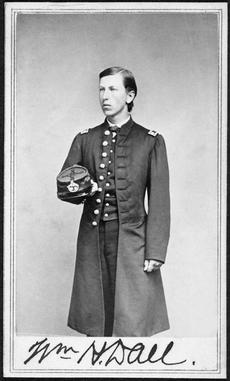William Healey Dall: Alaskan Explorer
 Dean of Alaskan explorations, William Healey Dall (1845–1927) began his scientific career as a member of the Scientific Corps of the Alaskan Western Union Telegraph Expedition in 1865. In 1871, he was appointed to the United States Coast Survey, where he continued his studies of Alaska and the northern Pacific Coast. Dall left the Coast Survey in 1884 to accept the rank of Paleontologist with the United States Geological Survey, a position he held until 1925. Having assembled and described some of the collections of mollusks and other organisms held by the Smithsonian's United States National Museum since 1868, Dall served as Honorary Curator of the Museum's Division of Mollusks from 1880 until his death. A prolific writer, Dall published more than five hundred scientific papers. Among Dall's more important larger works are Alaska and its Resources, 1870, and Contributions to the Tertiary Fauna of Florida, 6 volumes, 1890-1903, which is still considered the most important American publication on Cenozoic molluscan paleontology.
Dean of Alaskan explorations, William Healey Dall (1845–1927) began his scientific career as a member of the Scientific Corps of the Alaskan Western Union Telegraph Expedition in 1865. In 1871, he was appointed to the United States Coast Survey, where he continued his studies of Alaska and the northern Pacific Coast. Dall left the Coast Survey in 1884 to accept the rank of Paleontologist with the United States Geological Survey, a position he held until 1925. Having assembled and described some of the collections of mollusks and other organisms held by the Smithsonian's United States National Museum since 1868, Dall served as Honorary Curator of the Museum's Division of Mollusks from 1880 until his death. A prolific writer, Dall published more than five hundred scientific papers. Among Dall's more important larger works are Alaska and its Resources, 1870, and Contributions to the Tertiary Fauna of Florida, 6 volumes, 1890-1903, which is still considered the most important American publication on Cenozoic molluscan paleontology.
 The Western Union Telegraph Expedition, 1865-1867, also known as the Russian-American Telegraph Expedition, was undertaken to study the possibility of setting up a communications system between North America and Europe by way of Alaska, the Bering Straits, and Asia. The expedition was organized in three divisions, working in Canada, Russian-America (Alaska), and Asia. Robert Kennicott, the veteran Alaskan explorer, was placed in charge of the Russian-American division. Under the auspices of the Smithsonian Institution and the Chicago Academy of Sciences, a Scientific Corps was established, with Kennicott in command, to accompany the Russian-American division and make collections in natural history. Naturalists who served as members of the Scientific Corps included William H. Dall, Henry M. Bannister, and Henry W. Elliott. After the death of Kennicott on May 13, 1866, at just 21 years old, Dall became chief of the Scientific Corps and led the survey team to the Bering Strait. He later published the first English-language reports on the natural history of the Yukon and Alaskan territories, The Yukon Territory. The expedition was terminated in July 1867 due to the laying of the Atlantic Cable which successfully connected communications between Europe and North America.
The Western Union Telegraph Expedition, 1865-1867, also known as the Russian-American Telegraph Expedition, was undertaken to study the possibility of setting up a communications system between North America and Europe by way of Alaska, the Bering Straits, and Asia. The expedition was organized in three divisions, working in Canada, Russian-America (Alaska), and Asia. Robert Kennicott, the veteran Alaskan explorer, was placed in charge of the Russian-American division. Under the auspices of the Smithsonian Institution and the Chicago Academy of Sciences, a Scientific Corps was established, with Kennicott in command, to accompany the Russian-American division and make collections in natural history. Naturalists who served as members of the Scientific Corps included William H. Dall, Henry M. Bannister, and Henry W. Elliott. After the death of Kennicott on May 13, 1866, at just 21 years old, Dall became chief of the Scientific Corps and led the survey team to the Bering Strait. He later published the first English-language reports on the natural history of the Yukon and Alaskan territories, The Yukon Territory. The expedition was terminated in July 1867 due to the laying of the Atlantic Cable which successfully connected communications between Europe and North America.
CLASSROOM ACTIVITIES
PRIMARY SOURCES
- Description of Indian Life in Alaska
- Viewing the Aurora Borealis and an eclipse of the moon
- William Healey Dall Image files (zip file)
- Image Gallery: William Healey Dall
FURTHER EXPLORATION
- Dall, William H. The Yukon Territory: The Narrative of W.H. Dall, Leader of the Expedition to Alaska in 1866-1868. London: Downey & Co., 1898.
- Dall, William H. Contributions to the Tertiary Fauna of Florida. Vols. 1-6. Philadelphia, PA: Wagner Free Institute of Science, 1890-1903. Click here to read Volume 3.
- William Healey Dall Biography, National Academy of Sciences.
- "Harriman Expedition Retraced: William Healey Dall," PBS website.
